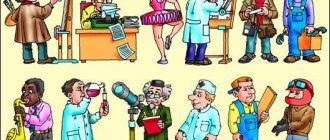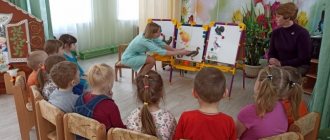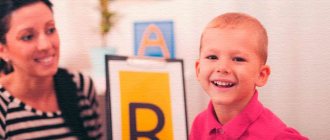- Speech therapist.No
- FFNR
- Development of phonemic awareness
Phonemic awareness is the ability to perceive and distinguish speech sounds—phonemes.
Violation of phonemic perception leads to the fact that the child does not perceive by ear (does not differentiate) speech sounds that are close in sound or similar in articulation. His vocabulary is not filled with words that contain sounds that are difficult to distinguish. Subsequently, the baby begins to lag significantly behind the age norm.
The development of phonemic perception underlies the work on correcting sound pronunciation, the formation of lexical and grammatical concepts, and teaching reading and writing.
Distinguishing words that are similar in sound composition
Exercise 3 Repeat two words after an adult and determine whether they sound similar:
|
|
|
Exercise 4 Repeat after the adult, first two then three similar words in the given order:
|
|
Exercise 5 An adult clearly pronounces pairs of words and asks the child to determine whether the names he hears are the same or different:
|
|
Exercise 6
Of the four words spoken by an adult, the child must choose and name the word that is different from the rest:
- com - com - cat - com
- ditch - cocoa - ditch - ditch
- duckling - duckling - duckling - kitten
- booth - letter - booth - booth
- screw - screw - screw - bandage
- minute - coin - minute - minute
- buffet - bouquet - buffet - buffet
- Ticket - ballet - ballet - ballet
- pipe - booth - booth - booth
Exercise 7
An adult invites the child to finish the couplet by choosing a suitable rhyming word:
| I dropped the briefcase from my hands, it was so big on the branch... (beetle). A nimble bear was walking through the forest, and... (a bump) fell on him. There are evil animals here in the forest, Lock them at night... (doors). We collected cornflowers on our heads... (wreaths). And back and forth It can sail... (steamboat). | Hush, Tanechka, don’t cry, Don’t drown in the river... (ball). One evening two mice took Petya away... (books). Vlad doesn’t crawl onto the spruce tree. In his hands... (briefcase). The dog brought a bouquet to the goat, It will be filling for her... (lunch). Don’t tremble, Seryozhka, this is ours... (cat). |
Lesson “Development of auditory perception, speech and non-speech sounds”
Municipal budgetary preschool educational institution
kindergarten No. 44 “Cinderella”
Stary Oskol urban district of Belgorod region
Summary of the lesson-game
«Development of auditory perception, speech and non-speech sounds»
For preschoolers 5-7 years old with mental retardation
Teacher speech therapist
Kotelnikova Inna Vasilievna
Stary Oskol
2018
Summary of the lesson-game
“Development of auditory perception, speech and non-speech sounds”
Compensating group:
preschoolers 5-7 years old with mental retardation.
Target:
creation of psychological and pedagogical conditions for the development of phonemic perception and education of a value-based attitude towards one’s health.
GCD tasks:
Educational:
to form the concept of “sound”, the ability to distinguish between speech and non-speech sounds (musical sounds, the voices of animals and birds, household noises), to activate cognitive activity, to help broaden one’s horizons.
Educational:
develop phonemic processes; general, fine and articulatory motor skills of children; breath.
Educational:
develop the ability to listen and listen, the ability to competently answer questions.
Implemented technologies:
technology of activity and health-forming approaches.
Teaching methods:
visual, verbal, practical.
Main forms of training organization:
joint activities to achieve results during group work; individual work; independent creative activity.
Expected results:
increasing auditory perception, speech activity of children, improving psycho-emotional well-being.
Equipment
: a toy “sun”, toys for the development of speech exhalation (balloons on a string, musical instruments), glasses, paper, spoons, bags, a surprise box, audio recordings of songs from the cartoon “The Bremen Town Musicians”, voices of poultry and animals, pictures with the image of fairy tale characters, video recording “Pets and Birds”, mirrors (according to the number of children), a hoop.
Course of
the lesson-game
1. Organizational moment.
Teacher speech therapist:
- Hello guys! Let's say hello to each other: say the name of the neighbor on the right and convey to him a joyful mood along with the “sunshine” toy.
Children stand in a circle, turn their heads, say: “Hello, Alina, Sasha, Dima! etc." and with a smile on their faces they pass each other the “sunshine” toy (Appendix 1).
2. Motivational situation
The speech therapist teacher shows a beautiful box and an illustration with the characters from the fairy tale “The Town Musicians of Bremen” (Appendix 2):
– This box was sent to us by the characters of the cartoon “The Bremen Town Musicians” and they asked us to guess what musical instruments were in the box. Today we will learn to distinguish the sounds of different musical instruments and the sounds of surrounding objects.
Children close their eyes, listen to the sounds of a tambourine, rattle, pipe, bell, then guess the instrument and find the corresponding picture (Appendix 3).
3. Exercise with a handkerchief.
Children sit on chairs. The exercise is performed to the musical accompaniment of a song from the cartoon “The Town of Bremen.” Children must pass the handkerchief to a neighbor and at the same time sing “I give it to you.” The speech therapist teacher ensures that each child sings the phrase to the best of his ability. After playing, ask what musical instrument was played in the song.
4. Development of facial muscles “I can do this.”
The speech therapist teacher reads poetry and shows children pictograms depicting various emotions (Appendix 4). Children try to repeat the mimic exercise after the heroes of the fairy tale. If difficulties arise, the teacher provides individual assistance to the child.
– We know how to smile (depicts facial expressions of joy),
– We know how to be surprised (depicts facial expressions of surprise),
– We know how to get angry (depicts facial expressions of anger),
– We know how to be upset (depicts facial expressions of grief).
5. Development of articulatory motor skills.
Reinforcing the basic articulation exercises in front of a mirror (acquaintance is carried out individually): “Smile”, “Needle”, “Spatula”, “Swing” (Appendix 5).
6. Dynamic pause.
Development of general motor skills and auditory attention.
Children stand in a circle, hearing the tambourine, begin to run in a circle. When they hear the bell, they raise their arms up and swing them from side to side.
7. Formation of auditory perception. Conversation with children.
Teacher speech therapist:
- Children, did you just guess the different sounds that you listened to?
-Ears. Children show their ears. Show the ears of the heroes of the fairy tale “The Town Musicians of Bremen” shown in the picture (Appendix 2).
Teacher speech therapist:
– In order for us to hear well, we need to take care of our ears. You cannot shout loudly in your ears, put foreign objects in your ears, or walk in cold weather without a hat.
8. Game “What rustles, what rings?”
The speech therapist teacher shows various objects and offers to listen to the sounds they make, and children with their eyes closed guess the object (glasses, paper, spoons, bags) based on the sound.
Then the guys go out one by one and perform various actions (rustling with paper and bags, knocking with an iron spoon on an iron spoon, glass glasses, etc.). The rest, with their eyes closed, guess the objects that make these sounds.
9. Game for developing breathing and voice “Blow like a breeze.”
The speech therapist teacher invites children to inhale air through their noses, stretch out their lips with a “tube” and blow on paper toys for inflating, balloons cut out of paper and attached to a string (Appendix 6).
10. Game “Who votes?”
The speech therapist teacher includes a CD with recordings of the voices of poultry and animals. After each listening, he names whose voice the children heard. Then the children independently guess the voices of domestic birds and animals. Then the teacher shows the video “Pets and Birds” to the children (the video “Pets and Birds” is attached).
11.
Low mobility game “Helpers”.
Children stand and hold the hoop with one hand. The exercise is performed with musical accompaniment. Children need to move in a circle while listening to poems read by a speech therapist teacher.
- We are walking in the sun -
- We strengthen the legs,
- To put away the toys -
- We're helping mom.
If children cannot move independently, an adult helps them (the type of assistance depends on the severity of the impairment). The exercise becomes more complicated by increasing the number of circles.
12. Result
of the game lesson .
The speech therapist teacher shows a surprise box with musical instruments and asks the children:
– What instruments did they like?
– How do we listen to different sounds?
– What games did you like to play the most?
The speech therapist teacher listens to the children’s answers and evaluates the children’s work in class.
Then he invites the children to stand in a circle, pass each other the “sun” toy and smile if they liked the activity.
Annex 1
Appendix 2
Appendix 3
Appendix 4
Appendix 5
Appendix 6
Syllable differentiation
Exercise 8 Repeat the syllable series after the adult, changing the stressed syllable:
|
|
|
Work with syllable rows is carried out in a similar way:
|
|
Exercise 9 Repeat after an adult syllable combinations with a common consonant and different vowel sounds:
|
|
|
Exercise 10 Repeat after an adult syllable combinations with a common vowel and different consonants:
|
|
Then syllable combinations with the vowels O, U, Y are pronounced. Exercise 11 Repeat after an adult syllable combinations with consonant sounds that differ in deafness and voicedness:
|
|
|
Then syllable combinations with the vowels O, U, Y are pronounced. Exercise 12 Repeat after an adult syllable combinations with consonant sounds that differ in hardness and softness:
|
|
|
|
|
|
|
|
Exercise 13 Repeat after the adult syllable pairs with increasing one consonant sound (to form a confluence):
|
|
Then syllable combinations with the vowels O, U, Y are pronounced. Exercise 14 Repeat after an adult syllable combinations with a common combination of two consonants and different vowels:
|
|
Exercise 15 Repeat after the adult the syllable pairs with a change of consonant sounds in their combination:
|
|
|
Development of acoustic differentiation of non-speech and speech sounds
Correction begins with distinguishing noise and non-speech sounds. But this becomes accessible to the child only when he is already sufficiently organized: he has basic concentration and the ability to be productive.
With sufficient development of the child's attention, imitation and performance, you can move on to learning to distinguish a number of disorganized sounds of different nature, starting with a brighter, more pronounced sound, with the development of coarser differentiations: the clink of coins in a wallet, the clink of pencils in a glass, the sound of metal objects touching etc. Gradually, children learn to distinguish quieter, less intense sounds that are closer to each other: the noise of crumpling paper, the rustling of matches in a box, etc. That is, they gradually move on to the development of more subtle acoustic differentiations .
Signals from sounding toys and instruments are used. It is useful for the child to hold the toy in his hand and feel the vibration at the moment of sound. First, he observes how the teacher produces certain sounds and tries to evoke them himself. Then the speech therapist gestures for the child to close his eyes or turn away (perhaps by placing objects that produce sounds behind a screen, a screen), and he must distinguish the corresponding objects - the sources of sounds - only by sound.
When working, avoid clapping your hands, stomping on the floor, or knocking on the table, since in these cases it is not sound that is perceived, but vibration, vibration through bone conduction. Gradually, the sound and noise series becomes more complex, new sounds are included in it, first distant and dissimilar, then increasingly closer, requiring subtle acoustic work. This expands and organizes the child’s field of hearing. As this work is successful, a strong speech sound ( a, p, y)
etc.), which is associated with an object or phenomenon.
If a child gets tired quickly, becomes distracted, hyper-irritable, restless, or starts to yawn when slowing down, the work becomes less productive. You need to give him a rest or change his activities. Such exercises are carried out throughout the work, but in each lesson it is necessary to strictly dose the acoustic load
.
Each speech sound that the child begins to perceive, isolate, differentiate from non-speech, and then from other speech sounds, is associated with an object, picture, action, or specific situation, and becomes their designation. At the initial stages of work, to develop a conditional connection between sound and object, equivalent words, sound complexes (y -
locomotive, car;
p –
airplane, growling dog;
mu -
cow, etc.) in one of the strictly fixed meanings, the connection between a sound or combinations of sounds with an object or its image is established and fixed.
Using various correction tools to form a system of values
After differentiating a certain number of sounds, you can move on to distinguishing syllables, again in connection with a specific object or action, and simple words with strict subject correlation. The easiest are combinations of two vowels, a vowel and a consonant ( ua, ay, am
), consonant and vowel in an open syllable (
ma, pa, na, ta,
etc.).
A differentiation is made between isolated vowels and then vowels at the beginning of words. In the work, sound combinations and words that are difficult for auditory recognition are avoided (2-3 consonants in combination: kt, tv, stv
, etc.). The words that a child learns to distinguish first should be different in meaning, structure, and sound. Each word, when perceived, receives motor, visual or tactile reinforcement. Visual, mirror control, and face reading are widely used. The first words perceived by the child are pronounced with the same intonation. Emphasized intonation helps the child navigate communication; intonation coloring is the leading support in determining the meaning of addresses to him. Systematic work is being carried out to accumulate a passive vocabulary, and at the same time the development of one’s own speech is underway.
By naming, the child shows pictures and imitates the execution of movements. He learns a set of movements, which he gradually gets used to performing, first in a memorized order with verbal accompaniment from the teacher, and later separately according to verbal instructions: “Arms up, to the sides,” etc.
Interest in sounds is fostered against an emotional and playful background. The child not only learns to determine the nature of the sound by pointing to the corresponding sound source, but also to localize it in space, to determine the place where the sounding toy is hidden. In games, he gradually learns to distinguish the strength, duration and intensity of the sound signal, selectively reacting to certain sounds.
When accumulating words that a child understands, it is important that he simultaneously hears a word, sees, touches an object, and performs some action with it. The connection between a word and an object is established through repeated coincidence of auditory and visual sensations. It is important not to suppress children’s reactions to what they see and hear, but to enhance them, show surprise, interest, etc. Not only the names of objects, but also ideas about them are formed more easily if the child has the opportunity to manipulate them. To transform a word into a concept, to form a generalizing meaning, it is not just repetition that is important, but the development of the largest possible number of conditional connections, mainly motor ones. In the course of object-practical actions, the child must master the ability to perform as many tasks as possible with an object according to verbal instructions: drink milk, pour milk from a bottle, blow on milk
etc. Similar exercises for accompanying actions with speech teach the child to assimilate the grammatical standards of his native language.
If possible, we teach the child to perceive phrases and phrases as early as possible. The first of them are usually standardized: words are pronounced in a certain order, with unchanged intonation. The instructions given to the child are of an everyday nature. At first, he gets used to understanding only one person, and then, as his capabilities increase, the adults around the child are involved in this work.
The phrase is not understood in itself, but as part of a more general effect on the child’s nervous system. It is taken into account that the understanding of phrases at first only situationally depends on certain details, therefore it is not recommended to change the order of words or intonation when pronouncing.
The child learns to understand instructions. For example, “open the door”, “take a handkerchief”, “get a book” and others related to everyday situations and the course of the lesson. The work of teaching the understanding of such instructions is based on facial expressions and gestures, which helps the child to understand the entire complex visual-figurative-actional situation in combination with speech.
The ability to perceive develops slowly, understanding becomes possible only after it has been prepared by the visual and tactile-vibrational analyzer (sensation of the vocal folds during phonation, the strength and direction of the exhaled air stream, etc.).
Understanding speech depends on the situation, context, general state, emotional mood for the lesson and a number of other factors. During work, the speech flow is first dissected and then pronounced holistically.


![Producing the sound [L] to a child in stages. Articulation gymnastics, speech therapy exercises, pronunciation lessons with pictures](https://doktorobrubov.ru/wp-content/uploads/postanovka-zvuka-l-rebenku-poetapno-artikulyacionnaya-gimnastika-logopedicheskie-uprazhneniya-uroki-330x140.jpg)



